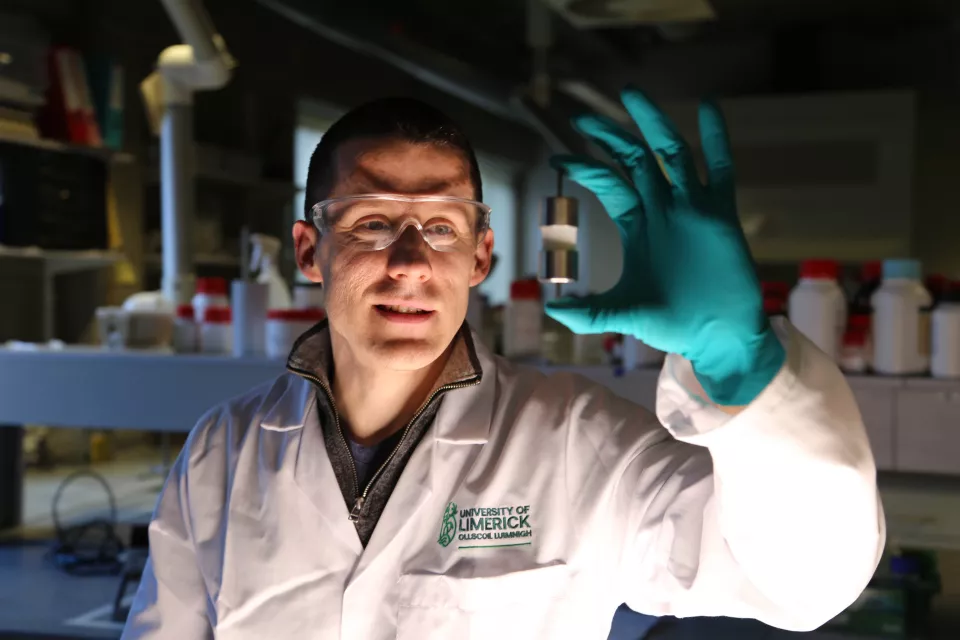
What powers the devices we have come to depend on and what does the future hold for battery technology? Dr. Hugh Geaney, recent recipient of the President’s Research Excellence and Impact Award and lecturer in chemistry in the Faculty of Science and Engineering, seeks to answer these questions and more in this month’s Research Spotlight
A chemistry lecturer and a Principal Investigator at the Bernal Institute, a Faculty of Science and Engineering Research Centre, Dr. Geaney’s research area is materials development for lithium-ion and other types of emerging battery technology.
Commercial lithium-ion battery technology has been around for roughly 30 years. First widely used in the Sony Walkman, we now find this type of battery in a lot of everyday items such as smartphones, laptops and electric vehicles to name but a few. With the global focus on renewables and storing energy generated from these sources, there is a need to improve this technology and look beyond it. Hugh explains:
“What will happen if we try to base current and emerging technologies on lithium is that we will run out eventually. What we need to do is look to improve lithium-based technologies, which we are doing as part of our research, and look beyond lithium-ion to meet future needs as well.”
Part of Hugh’s research is based on the use of nanomaterials for battery development. These smaller-than-microscopic materials can already be found in many electronic items.
“The nanometer scale is a billionth of a metre, we are talking about more than a thousand times narrower than the width of a human hair. When you have materials this small, they process unusual properties, they start to take on new properties that you can use. Nanomaterials are used in LCD TVs, you can use them as lightweight structural materials, and batteries.”
“One of the things that is important from the research side is understanding the link between the properties you have at the nanoscale and the final device. The great thing about using some of the equipment we have available in the Faculty of Science and Engineering, like the electron microscopy, is that you can look at the material before you put it in a battery and after it has run for 100 cycles in a battery and you can see how it has changed. You can really interrogate it, and this allows us to continually improve the process through testing.”
There is no one size fits all approach when it comes to battery development and each battery is specifically designed to meet the functionality of each device.
“The device’s requirements mean the battery must be produced in a certain way; the elements used and how they are combined will affect the battery’s performance. For example, you could have one that performs well at low temperatures, one that gives greater acceleration for your electric vehicle, and one that is not so good in this area.”
Hugh has always been interested in nanotechnology, getting his first experience researching these materials during his undergraduate degree in Pharmaceutical and Industrial Chemistry at UL, then taking this area of specialisation through to his PHD in UL and first postdoc in UCC. This pathway led him to the area of energy storage - an area that was clearly emerging as there is always a need for better batteries.
“This research is not abstract. It is incredibly obvious what the real-world implications are. The metric that is typically most important is energy density, which is storing more energy in a given volume. If you double your energy density, you might be able to double your range in your electric vehicle or double the battery life on your phone before you need to charge it again. For some applications like stationary storage, energy density is less important and cost and sustainability factors take over.”
Hugh and the team in the Faculty of Science and Engineering have been working on Lithium-ion development for more than 10 years. This research has led to the University of Limerick being recognised nationally and internationally as being a centre of excellence in this area, working on Horizon Europe projects with SMEs and also larger industry.
“I’m hugely proud of the fact that I have contributed to the growth of the expertise at the University of Limerick in this space. We are the biggest hub of battery research in Ireland. We have coordinated two Horizon Europe projects, the first ever battery projects coordinated from Ireland.”
The opportunity to work with industry brings the rewards of being able to see a project from its Genesis to real-world application, and it is this incentive that drives the team at UL.
“We take our starting material and work with our industry partners to try to upscale it in terms of making it into larger cells and prototypes. Through prototyping and testing we determine if this is what they need. The ultimate goal is to get beyond the lab and into reality.”
